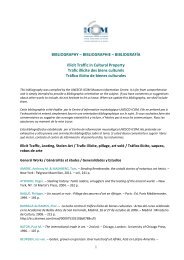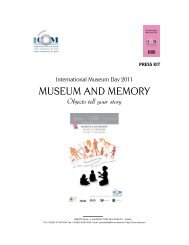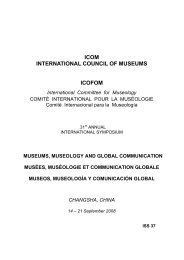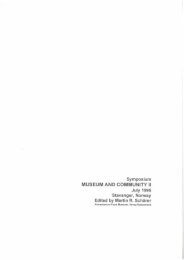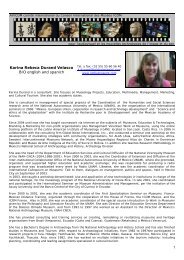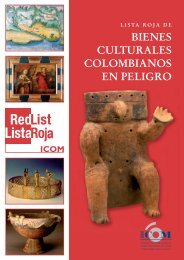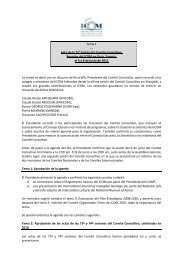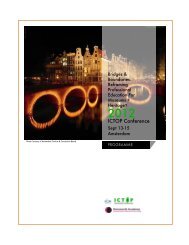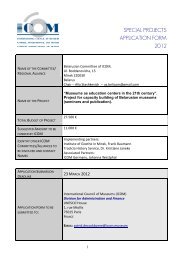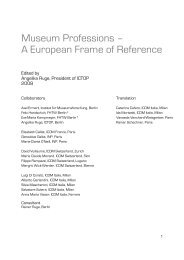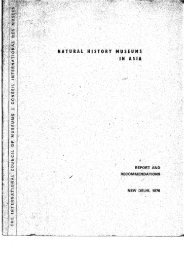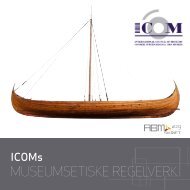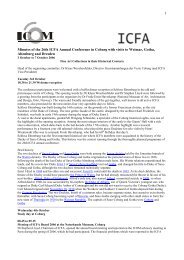Key Concepts of Museology - ICOM
Key Concepts of Museology - ICOM
Key Concepts of Museology - ICOM
You also want an ePaper? Increase the reach of your titles
YUMPU automatically turns print PDFs into web optimized ePapers that Google loves.
72<br />
establishment. The notion <strong>of</strong> public<br />
is central to almost all <strong>of</strong> the current<br />
defi nitions <strong>of</strong> museum: “institution<br />
… at the service <strong>of</strong> society and its<br />
development, open to the public”<br />
(<strong>ICOM</strong>, 2007). It is also a “collection<br />
… the conservation and display<br />
<strong>of</strong> which are <strong>of</strong> public interest<br />
and intended for public knowledge,<br />
education and enjoyment” (Law on<br />
the museums <strong>of</strong> France, 2002), or<br />
again “an institution which owns<br />
and uses material objects, preserves<br />
them and exhibits them to the public<br />
according to regular opening hours”<br />
(American Association <strong>of</strong> Museums,<br />
Accreditation Program, 1973); the<br />
defi nition published in 1998 by the<br />
Museums Association (UK) replaced<br />
the adjective ‘public’ with the noun<br />
‘people’.<br />
The very notion <strong>of</strong> public closely<br />
associates the museum activities with<br />
its users, even those who are intended<br />
to benefi t from it but do not use its services.<br />
By users we mean <strong>of</strong> course the<br />
visitors – the public at large – about<br />
whom we think fi rst <strong>of</strong> all, forgetting<br />
that they have not always played the<br />
central role that the museum recognises<br />
today, because there are many<br />
specifi c publics. Museums have opened<br />
up to everyone only gradually,<br />
being fi rst <strong>of</strong> all a place for artistic<br />
training and for the territory <strong>of</strong> the<br />
learned and scholarly. This opening,<br />
which has led museum staff to take<br />
an increasing interest in all its visitors<br />
and also in the population that<br />
does not visit museums, has fostered<br />
the growth <strong>of</strong> ways <strong>of</strong> interpreting<br />
the museum to all the users, as we<br />
can see by the new words used over<br />
time: people, public at large, nonpublic,<br />
distant public, disabled or<br />
frail; users, visitors, observers, spectators,<br />
consumers, audience, etc. The<br />
development <strong>of</strong> the pr<strong>of</strong>essional fi eld<br />
<strong>of</strong> exhibition critics, many <strong>of</strong> whom<br />
present themselves as “public advocates”<br />
or “for the voice <strong>of</strong> the public”,<br />
is evidence <strong>of</strong> this current tendency<br />
to reinforce the idea that the public is<br />
at the core <strong>of</strong> general museum operations.<br />
Essentially since the end <strong>of</strong> the<br />
1980s we talk <strong>of</strong> a real “turn towards<br />
the public” in museal action, to show<br />
the growing importance <strong>of</strong> museum<br />
visits and take account <strong>of</strong> the needs<br />
and expectations <strong>of</strong> visitors (which<br />
corresponds to what we also call<br />
“the commercial trend <strong>of</strong> museums”,<br />
even if the two do not necessarily go<br />
together).<br />
3. By extension, in the models <strong>of</strong><br />
community museums and ecomuseums,<br />
the public has been extended<br />
to cover the whole <strong>of</strong> the population<br />
in the areas in which they are set.<br />
The population is the basis <strong>of</strong> the<br />
museum and in the case <strong>of</strong> the ecomuseum,<br />
it becomes the main player<br />
and no longer the target <strong>of</strong> the establishment<br />
(see Society).<br />
DERIVATIVES: DISABLED PUBLIC, MINORITY PUBLIC,<br />
NON-PUBLIC, PUBLIC AT LARGE, PUBLIC RELATIONS,<br />
PUBLICITY, TARGET PUBLIC.<br />
CORRELATED: AUDIENCE, ASSESSMENTS,<br />
COMMUNITY, CUSTOMERS, ECOMUSEUM, EVALUATION,<br />
EVALUATORS, LOYALTY BUILDING, PEOPLE, POPULATION,<br />
PRIVATE, SOCIETY, SPECTATORS, ENQUIRIES, TOURISTS,<br />
USERS, VISITING, VISITORS.



